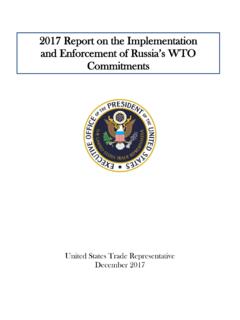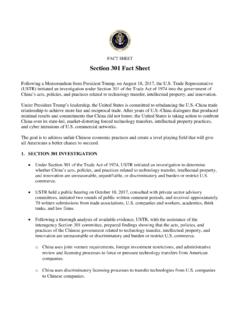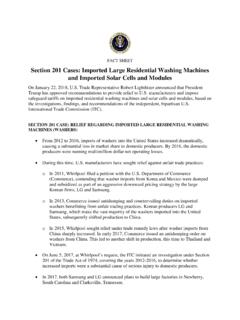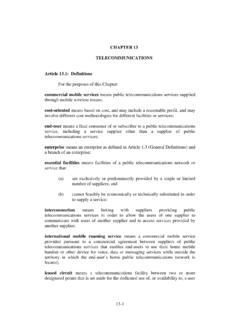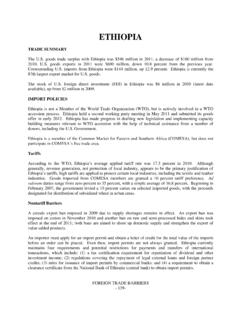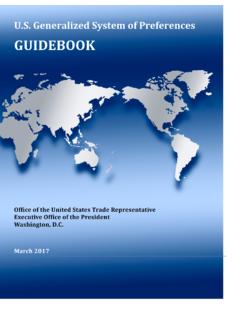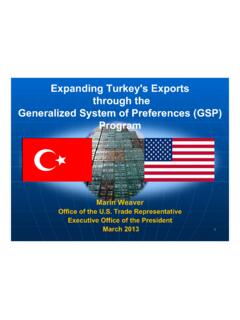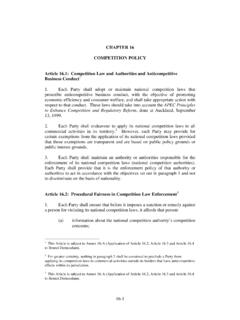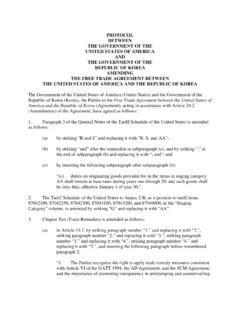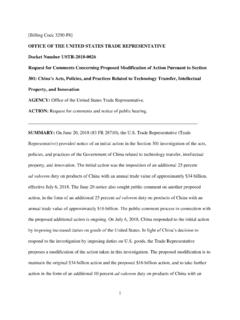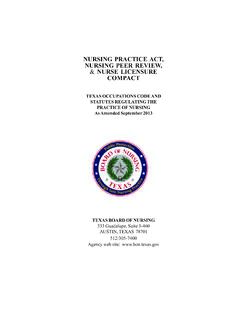Transcription of Special 301 Report - Office of the United States Trade ...
1 2020 Special 301 ReportAPRIL 20202020 Special 301 Report United States Trade REPRESENTATIVE ROBERT E. LIGHTHIZER ACKNOWLEDGEMENTS The Office of the United States Trade Representative (USTR) is responsible for the preparation of this Report . United States Trade Representative Robert Lighthizer gratefully acknowledges the contributions of staff to the writing and production of this Report and extends his thanks to partner agencies, including the following Departments and agencies: State; Treasury; Justice; Agriculture; Commerce, including the International Trade Administration and the Patent and Trademark Office ; Labor; Health and Human Services, including the Food and Drug Administration; Homeland Security, including Customs and Border Protection, Immigration and Customs Enforcement, and the National Intellectual Property Rights Coordination Center; and the United States Agency for International Development.
2 USTR also recognizes the contributions of the Office of the Intellectual Property Enforcement Coordinator, as well as those of the United States Copyright Office . In preparing the Report , substantial information was solicited from embassies around the world, from Government agencies, and from interested stakeholders. The draft of this Report was developed through the Special 301 Subcommittee of the interagency Trade Policy Staff Committee. 3 TABLE OF CONTENTS EXECUTIVE SUMMARY .. 4 section I: Developments in Intellectual Property Rights Protection, Enforcement, and Related Market Access .. 12 section II: Country Reports .. 39 PRIORITY WATCH LIST .. 39 China .. 39 Indonesia.
3 48 India .. 50 Algeria .. 53 Saudi Arabia .. 54 Russia .. 56 Ukraine .. 58 Argentina .. 60 Chile .. 62 Venezuela .. 64 WATCH LIST .. 65 Thailand .. 65 Vietnam .. 66 Pakistan .. 67 Turkmenistan .. 68 Uzbekistan .. 69 Egypt .. 70 Kuwait .. 71 Lebanon .. 72 United Arab Emirates .. 73 Romania .. 74 Turkey .. 75 Barbados .. 76 Bolivia .. 77 Brazil .. 78 Canada .. 79 Colombia .. 80 Dominican Republic .. 81 Ecuador .. 82 Guatemala .. 83 Mexico .. 84 Paraguay .. 85 Peru .. 86 Trinidad & Tobago .. 87 ANNEX 1: Special 301 Statutory Basis .. 88 ANNEX 2: Government-Sponsored Technical Assistance and Capacity Building .. 90 4 EXECUTIVE SUMMARY A top Trade priority for the Administration is to use all possible sources of leverage to encourage other countries to open their markets to exports of goods and services and to provide adequate and effective protection and enforcement of intellectual property (IP) rights.
4 Toward this end, a key objective of the Administration s Trade policy is ensuring that owners of IP have a full and fair opportunity to use and profit from their IP around the globe. The Special 301 Report ( Report ) is the result of an annual review of the state of IP protection and enforcement in trading partners around the world, which the Office of the United States Trade Representative (USTR) conducts pursuant to section 182 of the Trade Act of 1974, as amended (the Trade Act, 19 2242). Congress amended the Trade Act in 1988 specifically to provide for the development of an overall strategy to ensure adequate and effective protection of intellectual property rights and fair and equitable market access for United States persons that rely on protection of intellectual property rights.
5 1 In particular, Congress expressed its concern that the absence of adequate and effective protection of United States intellectual property rights, and the denial of equitable market access, seriously impede the ability of the United States persons that rely on protection of intellectual property rights to export and operate overseas, thereby harming the economic interests of the United States . 2 This Report provides an opportunity to call out foreign countries and to expose the laws, policies, and practices that fail to provide adequate and effective IP protection and enforcement for inventors, creators, brands, manufacturers, and service providers. The identification of the countries and IP-related market access barriers in the Report and of steps necessary to address those barriers are a critical component of the Administration s aggressive efforts to defend Americans from harmful IP-related Trade barriers.
6 Specifically, this Administration continues to closely monitor developments in, and to engage with, those countries that have been on the Priority Watch List for multiple years. Over the coming weeks, USTR will review the developments against the benchmarks established in the Special 301 action plans for those countries. For countries failing to address concerns, USTR will take appropriate actions, which may include enforcement actions under section 301 of the Trade Act or pursuant to World Trade Organization (WTO) or other Trade agreement dispute settlement procedures. The Report identifies foreign trading partners where IP protection and enforcement has deteriorated or remained at inadequate levels and where persons who rely on IP protection have difficulty with fair and equitable market access.
7 For example: 1 Omnibus Trade and Competitiveness Act of 1988, 1303(a)(2), 102 Stat. 1179. 2 Id. 1303(a)(1)(B); see also S. Rep. 100-71 at 75 (1987) ( Improved protection and market access for intellectual property goes to the very essence of economic competitiveness for the United States . The problems of piracy, counterfeiting, and market access for intellectual property affect the economy as a whole. Effective action against these problems is important to sectors ranging from high technology to basic industries, and from manufacturers of goods to service businesses. ). 5 USTR continues to place China on the Priority Watch List and section 306 monitoring remains in effect.
8 China s placement on the Priority Watch List reflects concerns with China s system of pressuring and coercing technology transfer, and the continued need for fundamental structural changes to strengthen IP protection and enforcement, including as to Trade secret theft, obstacles to protecting trademarks, online piracy and counterfeiting, the high-volume manufacturing and export of counterfeit goods, and impediments to pharmaceutical innovation. Under section 301 of the Trade Act of 1974, USTR has taken action to address a range of unfair and harmful Chinese acts, policies, and practices related to technology transfer, IP, and innovation. USTR also initiated dispute settlement proceedings at the WTO to address discriminatory licensing practices.
9 Structural impediments to administrative, civil, and criminal enforcement continue to undermine IP protections, as do certain information communications technology (ICT), IP-ownership, and research and development localization requirements. Over the past year, the United States engagement of China began to demonstrate key progress with the signing of the China Economic and Trade Agreement in January The agreement requires changes in China s acts, policies, and practices, including structural reforms and other changes to China s legal and regulatory regime to address numerous longstanding concerns of a wide range of industries. USTR identifies India on the Priority Watch List for lack of sufficient measurable improvements to its IP framework on long-standing and new challenges that have negatively affected right holders over the past year.
10 Long-standing IP challenges facing businesses in India include those which make it difficult for innovators to receive, maintain, and enforce patents in India, particularly for pharmaceuticals; ineffectual enforcement activities, copyright4 policies that fail to incentivize the creation and commercialization of content, and an outdated and insufficient Trade secrets legal framework. In addition to these long-standing concerns, India also further restricted the transparency of information provided on state-issued pharmaceutical manufacturing licenses, continues to apply restrictive patentability criteria to reject pharmaceutical patents, and still has not established an effective system for protecting against the unfair commercial use, as well as the unauthorized disclosure, of undisclosed test or other data generated to obtain marketing approval for pharmaceuticals and certain agricultural chemical products.
